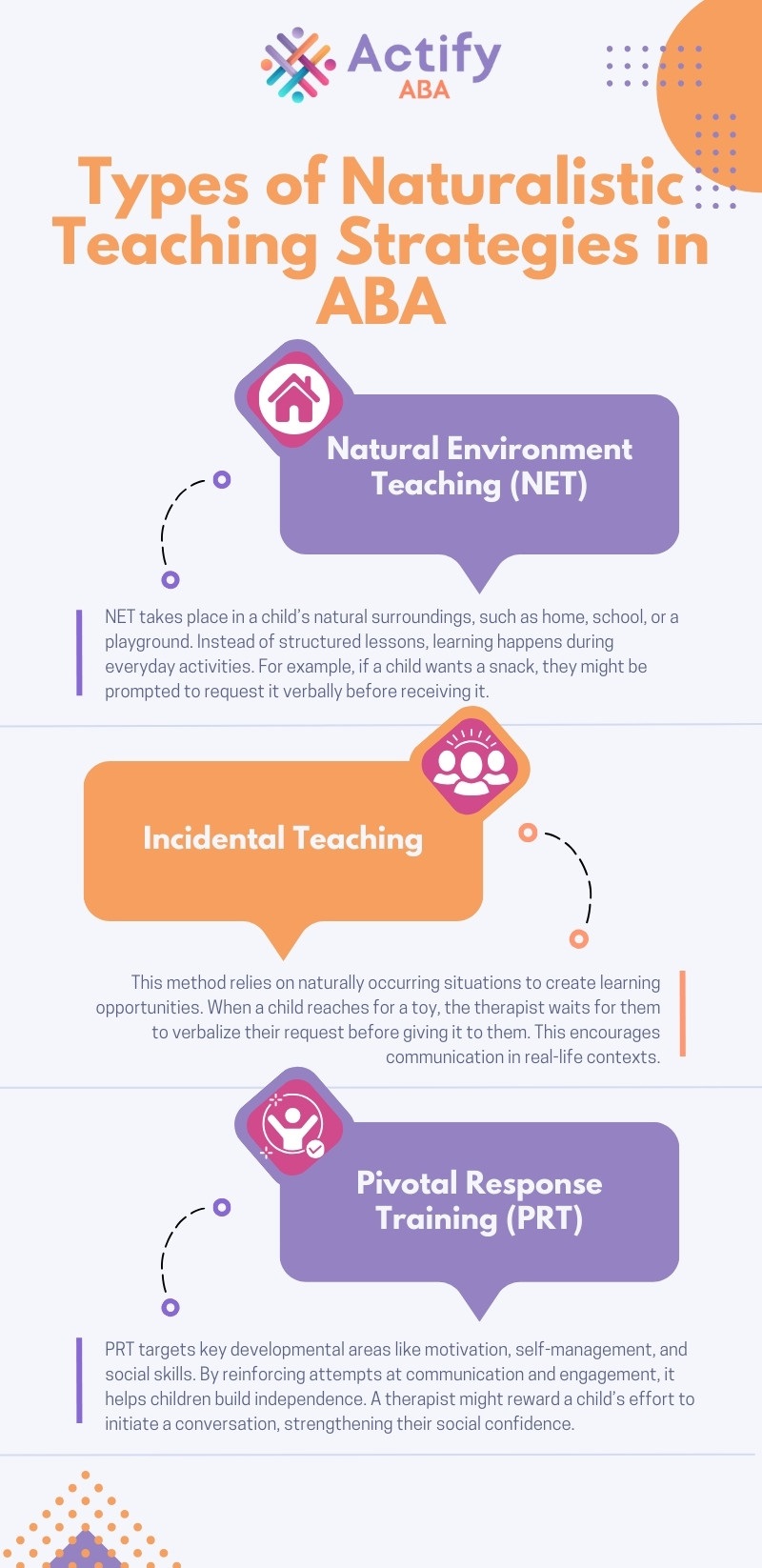
Key Points:
- Naturalistic teaching strategies use real-life environments to promote learning and skill development.
- These strategies improve communication, social, and daily living skills through child-led, engaging interactions.
- Parents can use naturalistic techniques at home to reinforce ABA goals in everyday situations.
Children learn best when they’re engaged in what they love. Whether it’s playing with blocks, helping in the kitchen, or chatting with a friend, these everyday moments offer powerful learning opportunities. Naturalistic teaching in ABA harnesses these moments to build essential skills—without rigid drills or structured lessons.
What Are Naturalistic Teaching Strategies ABA?
Naturalistic teaching strategies are child-centered methods that teach skills through everyday activities and natural environments. Instead of rigid, structured sessions, learning happens during play, conversations, and daily routines, making it more engaging and meaningful for the child. This approach allows therapists and caregivers to follow the child’s interests, creating a more relaxed learning environment while still working toward specific goals.

Why Are Naturalistic Teaching Strategies Effective?
Naturalistic teaching strategies are effective because they use a child’s interests and everyday experiences to promote learning. By embedding skill development into real-life situations, these strategies encourage engagement, motivation, and better long-term retention. Here’s why they work so well:
Increases Engagement and Motivation
When children learn through their favorite activities, they stay more engaged. Instead of structured drills, ABA therapists use play, daily routines, and social interactions to teach important skills. This makes learning feel natural, enjoyable, and less like a chore.
Encourages Skill Generalization
Traditional teaching methods sometimes limit learning to specific settings. Naturalistic teaching ensures children can apply new skills across different environments—home, school, and community. This approach helps them adapt and use their skills in real-world situations.
Reduces Resistance to Learning
Some children resist structured lessons, but naturalistic teaching feels organic. When learning happens through play and routine interactions, children are more receptive. This lowers frustration and increases participation in learning experiences.
Supports Parent Involvement
Parents can easily integrate these strategies into daily life. Whether prompting a child to ask for a snack or encouraging social interactions, parents play a vital role in reinforcing ABA goals naturally throughout the day.
Several naturalistic teaching strategies are used in ABA therapy, each designed to promote learning in real-life settings. These methods focus on child-led interactions, making skill development more engaging and meaningful. Here are some of the most effective approaches:

Naturalistic Training ABA Example: How It Works in Real Life
Naturalistic teaching is all about embedding learning into everyday moments. Instead of structured lessons, therapists and parents use real-life situations to teach essential skills. This makes learning feel natural, engaging, and easier to apply outside of therapy sessions.
For example, imagine a child who struggles with communication. During snack time, instead of handing them a cookie immediately, a therapist might pause and encourage them to request it verbally or with gestures. This simple interaction teaches language skills in a way that feels meaningful and rewarding.
Another scenario could involve teaching social skills through play. If a child loves building blocks, the therapist might encourage them to ask a peer for a piece or take turns stacking blocks. These small but intentional moments help children develop social communication naturally.
Even daily routines offer learning opportunities. Brushing teeth, packing a bag, or getting dressed can all be used to build independence, following directions, and problem-solving skills through naturalistic ABA techniques.
When to Use Naturalistic Teaching Strategies
Naturalistic teaching strategies can be used throughout the day, making learning opportunities feel natural and engaging. These strategies are most effective when applied in real-life situations where children naturally interact with their environment, ensuring skills are learned and reinforced in meaningful ways.
- During Playtime – Play provides a perfect opportunity for children to practice language, problem-solving, and social skills. A therapist or parent can introduce new words, encourage turn-taking, or model appropriate behaviors while the child is engaged in an activity they enjoy, making learning feel effortless.
- Daily Routines – Everyday tasks like getting dressed, eating meals, or brushing teeth offer valuable teaching moments. Encouraging a child to request items, follow instructions, or complete steps independently helps build communication and self-help skills in a practical way.
- Social Interactions – Naturalistic strategies work well in peer interactions, such as playdates or group activities. Guiding a child to initiate conversations, take turns, or respond appropriately to social cues strengthens their ability to engage with others in a comfortable and natural setting.
How Can Parents Use Naturalistic Teaching at Home?
Parents play a vital role in reinforcing skills learned in ABA therapy. By integrating naturalistic teaching into daily life, they can help children practice communication, social, and life skills in a meaningful way. The key is to use everyday interactions as learning opportunities.
One effective strategy is following the child’s lead. Instead of directing activities, observe what interests them—whether it’s playing with cars, drawing, or cooking. Use these interests to encourage learning by asking questions, modeling new words, or prompting problem-solving. This keeps learning fun and engaging.
Another technique is creating teachable moments throughout the day. Encourage a child to request snacks, describe objects, or take turns during play. Small, consistent interactions help reinforce skills naturally, making learning part of everyday life.
Partner with Actify for Naturalistic ABA Therapy
Understanding and applying naturalistic training ABA examples can make a profound difference in your child’s development. By using real-life situations to teach and reinforce skills, these methods help children thrive beyond therapy sessions.
At Actify, we specialize in personalized ABA therapy that incorporates naturalistic strategies to promote meaningful learning. Our experienced team works closely with families to ensure skills are developed and practiced in everyday environments.
We proudly serve ABA therapy services for families in Maryland and surrounding areas. Contact us today to learn how our tailored ABA programs can support your child’s growth!
